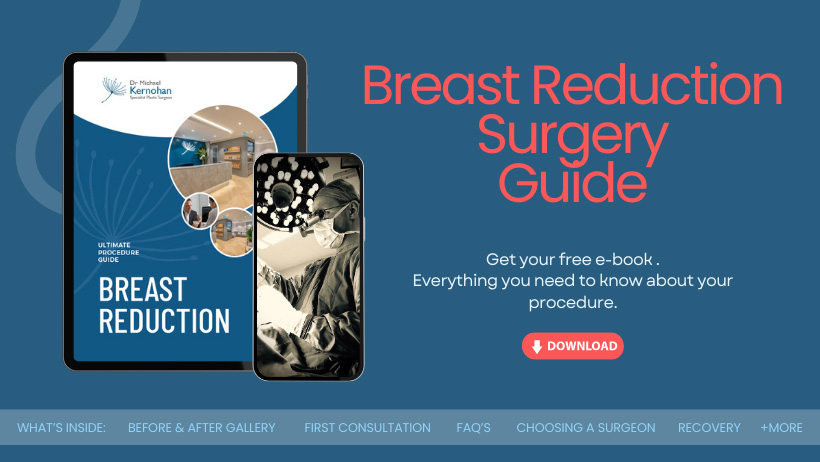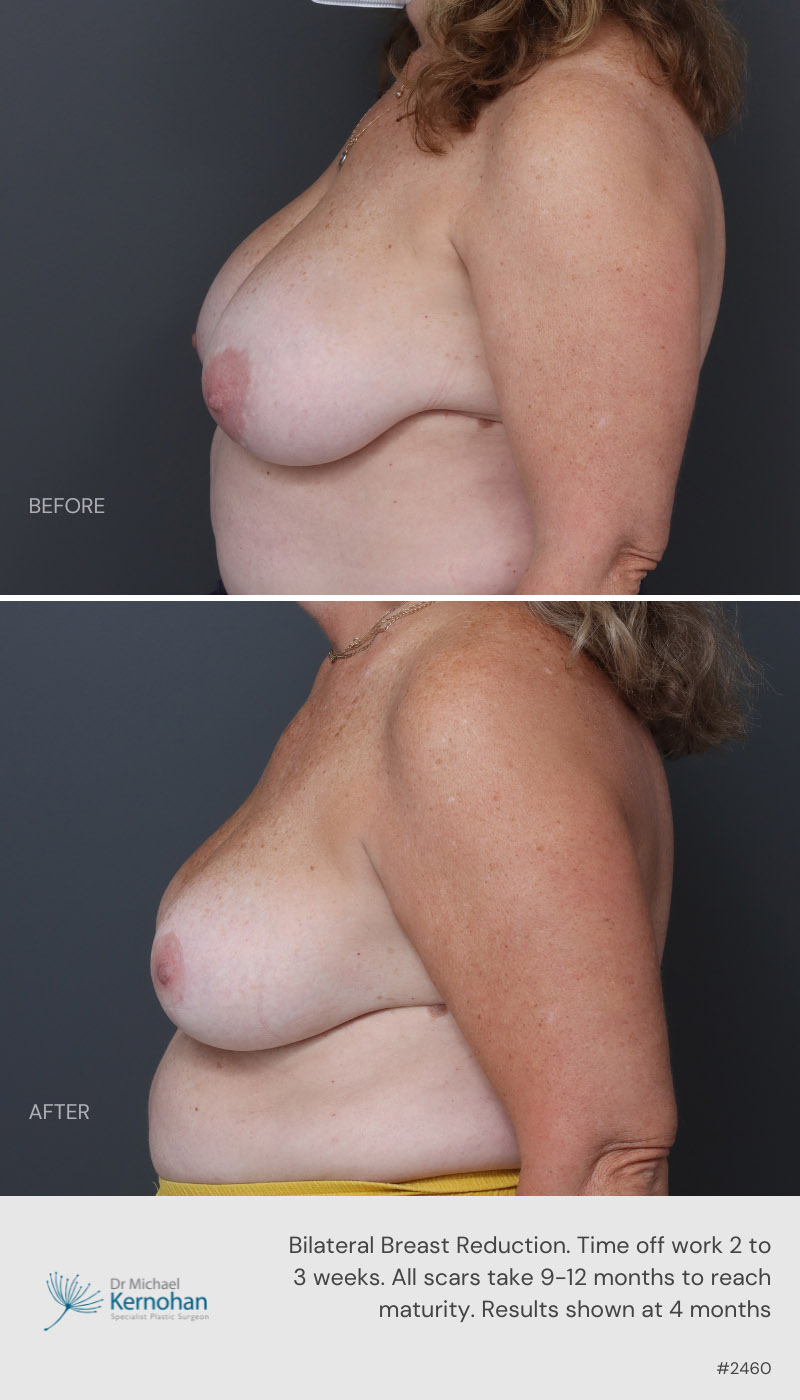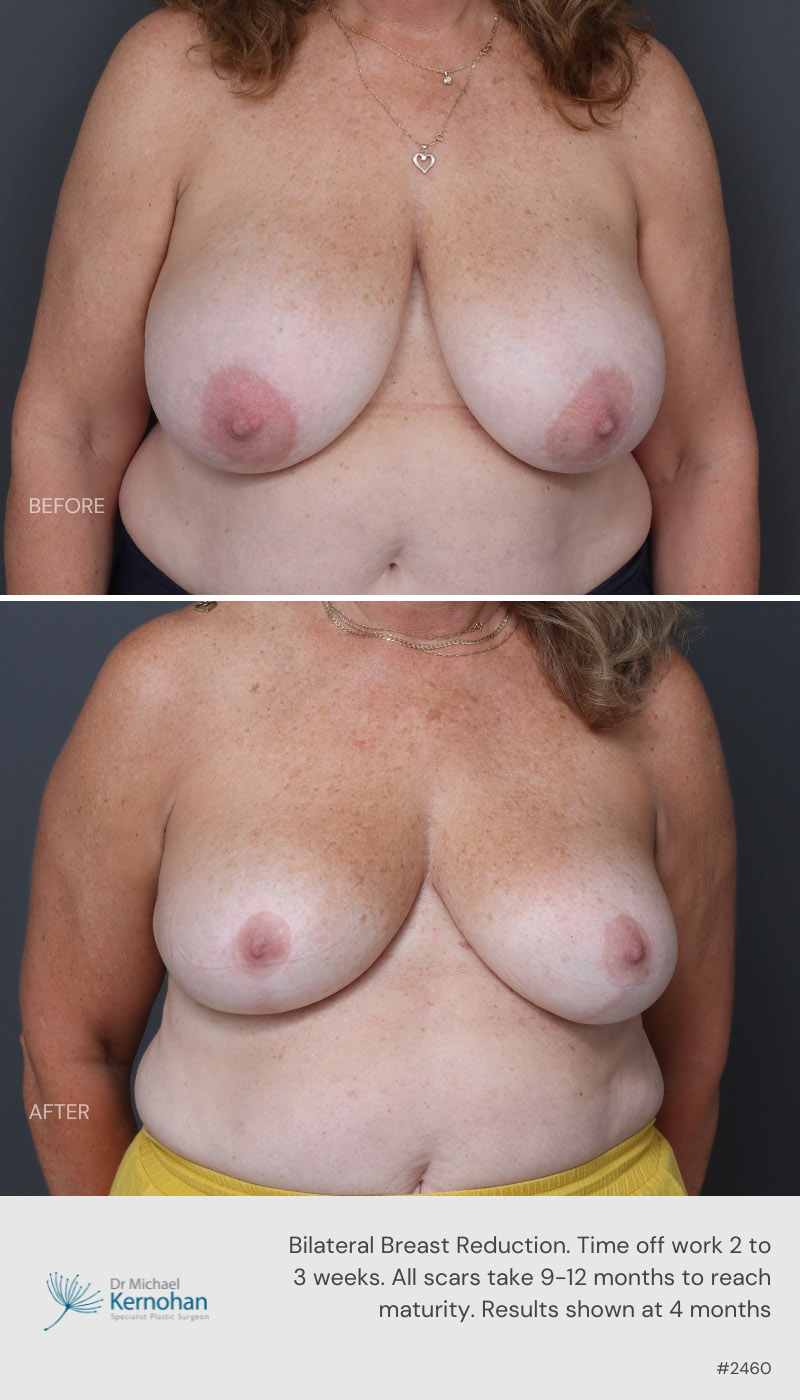Medicare Cover for Breast Reduction Surgery
Breast reduction surgery is a procedure designed to alleviate discomfort from overly large breasts. The surgery involves the removal of excess breast fat, glandular tissue, and skin, aiming to achieve a breast size in proportion with your body and to alleviate the discomfort associated with excessively large breasts. In Australia, Medicare may cover some of the costs associated with this surgery. However, it is important to understand that Medicare coverage is typically contingent on certain conditions being met, particularly those proving that the surgery is necessary for medical rather than cosmetic reasons. In this blog, Sydney Specialist Plastic Surgeon Dr Michael Kernohan will discuss the details of Medicare cover for breast reduction surgery in Sydney.
In distinguishing between cosmetic and medically necessary breast reduction procedures, it becomes clear that Medicare’s primary concern is alleviating physical health issues rather than enhancing appearance. While cosmetic breast reduction focuses on aesthetic outcomes, medically necessary breast reduction is aimed at resolving health concerns. This differentiation is crucial in the assessment process for Medicare coverage.
The process of obtaining Medicare coverage for breast reduction involves a series of steps, including:
- Initial consultation with a general practitioner and plastic surgeon to discuss the physical symptoms and explore treatment options
- Undergoing necessary assessments to establish the medical necessity of the surgery
- Submitting relevant documentation and applications to Medicare for coverage assessment
Even if you get Medicare coverage, it is important to be prepared for out-of-pocket costs. These may include surgeon’s fees, hospital charges, and other related expenses not fully covered by Medicare.
Take the Quiz
Details of Medicare Coverage
At its core, Medicare is designed to support patients in receiving medically necessary treatments that are essential for maintaining or improving health. This includes procedures deemed necessary to alleviate significant physical discomfort or to treat conditions that could lead to serious health complications.
When it comes to understanding what Medicare covers, it’s important to recognise the distinction between medically necessary treatments and cosmetic procedures. Medically necessary treatments are those required to address a health concern or condition. These procedures are often covered by Medicare, as they are seen as essential for the physical health of the patient. On the other hand, cosmetic procedures are generally aimed at enhancing appearance and are not covered by Medicare, as they are considered elective and not medically essential.
For individuals exploring options like surgery, understanding this distinction is essential. Breast reduction surgery, for instance, can fall into either category – medically necessary or cosmetic – based on the underlying reasons for the procedure. To determine whether this surgery is covered under Medicare, several factors are taken into account:
- Documentation of physical symptoms and health issues caused by the condition needing surgery
- Evidence that less invasive treatments have been tried and were not effective
- Professional evaluations and recommendations from your plastic surgeon
Criteria for Medicare Coverage
When considering Medicare coverage for breast reduction surgery in Australia, it’s important to understand the detailed criteria that determine eligibility. This surgery, while beneficial for some, is not automatically covered under Medicare. Coverage is contingent on a range of factors, with the central focus being on the medical necessity of the procedure.
Medical necessity, in the context of breast reduction, refers to the requirement that the surgery is needed to alleviate significant physical health issues rather than for aesthetic improvements. Medicare evaluates each case to determine whether the physical conditions experienced by the individual warrant this surgical intervention. The criteria for deeming breast reduction surgery as medically necessary include:
- Chronic pain: Patients must provide evidence of persistent pain related to the size of their breasts, which could include back, shoulder, or neck pain. This pain should be severe enough to interfere with daily activities
- Skin infections: Frequent or chronic skin infections under the breasts can qualify a patient for Medicare coverage. These infections are often due to the constant friction and lack of ventilation caused by large breasts
- Documented attempts at alternative treatments: Before approving surgery, Medicare usually requires evidence that other non-surgical treatments have been attempted but were not successful in alleviating the symptoms. These might include physical therapy, pain management strategies, or dermatological treatments for skin conditions
- Recommendations from your surgeon: A referral from your GP is necessary to see a plastic surgeon. Your plastic surgeon must attest to the medical necessity of the surgery in relation to your health conditions
- Impact on daily life: The patient must demonstrate how their breast size adversely affects their daily life. This can include limitations on physical activity, ongoing pain, or other physical restrictions
- Psychological impact: While the primary focus is on physical health issues, the psychological impact of these conditions can also be a consideration. Patients may need to demonstrate how their condition affects their mental health, although this is typically considered in conjunction with physical health issues
It’s important to remember that each case is assessed on an individual basis by Medicare. The decision to cover breast reduction surgery under Medicare is not taken lightly and involves a thorough evaluation of all these factors.
Medicare Item Numbers for Breast Reduction
In Australia, the Medicare system utilises specific item numbers to categorise and identify medical procedures, including breast reduction surgeries. For breast reduction, the relevant Medicare Item Numbers are 45523, 45520, and 45522. Each of these numbers corresponds to different aspects or conditions related to the surgery, and they play a crucial role in the process of seeking coverage. Additionally, if you have private health insurance, these item numbers are significant in determining whether your policy will cover the procedure.
These numbers are not just arbitrary codes but are essential to navigating the healthcare system’s protocols for treatment and reimbursement. The specific item numbers for breast reduction surgeries are:
- Item 45523: This code is used for cases involving Reduction mammaplasty (bilateral) with surgical repositioning of the nipple:
(a) for patients with macromastia who are experiencing pain in the neck or shoulder region; and
(b) not with insertion of any prosthesis;
other than a service associated with a service to which item 31512, 31513 or 31514 applies (H) - Item 45520: This item number applies to Reduction mammaplasty (unilateral) with surgical repositioning of nipple, in the context of breast cancer or developmental abnormality of the breast, other than a service associated with a service to which item 31512, 31513 or 31514 applies on the same side (H)
- Item 45522: This code is used for cases involving Reduction mammaplasty (unilateral) without surgical repositioning of the nipple:
(a) excluding the treatment of gynaecomastia; and
(b) not with insertion of any prosthesis;
other than a service associated with a service to which item 31512, 31513 or 31514 applies on the same side (H)
It’s important to note that the allocation of these item numbers to your surgical procedure is not automatic. There is a set of strict criteria that must be met, and these criteria are closely linked to the concept of medical necessity. In order to have your surgery categorised under one of these item numbers, you need to provide documentation that supports your claim. This documentation often includes.
If you are covered by private health insurance, these Medicare item numbers become even more significant. Most private health insurance policies in Australia will consider covering procedures that are recognised by Medicare. Therefore, if your breast reduction surgery is assigned one of these item numbers, there is a higher likelihood that your private health insurance will also provide coverage. However, it’s important to:
- Check your individual policy details as coverage can vary significantly between different health insurance plans
- Discuss with your insurance provider about the specifics of your coverage, especially in relation to these item numbers
- Prepare for additional costs or out-of-pocket expenses that may not be covered by Medicare or your private health insurance
The Role of Private Health Insurance
In Australia, private health insurance plays a complementary role to Medicare, the public health system. Understanding how private health insurance interacts with Medicare, especially in the context of procedures like breast reduction surgery, is important for making informed decisions about your healthcare.
Medicare provides the foundation for healthcare coverage, including certain types of surgeries that are deemed medically necessary. However, there are instances where Medicare coverage is limited or does not extend to certain aspects of healthcare. This is where private health insurance can be particularly beneficial. It can provide additional coverage that fills the gaps left by Medicare. For breast reduction surgery, this interaction between Medicare and private health insurance is crucial to understand.
The aspects of how private health insurance complements Medicare coverage include:
- Additional Coverage: Private health insurance may cover costs that are not covered by Medicare, such as some surgeon’s fees, hospital accommodation, and other related expenses
- Choice of Surgeon and Hospital: With private health insurance, you often have more flexibility in choosing your surgeon and hospital. This can provide you with options that might not be available through the public system
- Reduced Waiting Times: For elective surgeries, those covered by private health insurance may experience shorter waiting times compared to the public system
If you’re considering breast reduction surgery and have private health insurance, it’s important to understand the extent of your coverage. The specifics can vary greatly depending on your policy. Some policies may cover a significant portion of the surgery and associated costs, while others might offer more limited benefits. The aspects you should investigate with your private health insurer include:
- Coverage Extent: Find out what aspects of the breast reduction surgery are covered. This can include surgeon’s fees, anaesthetist fees, hospital costs, and post-operative care
- Gap Payments: Understand if there are gap payments, which are the difference between what Medicare and your private health insurance cover and the actual cost of the surgery and associated care
- Pre-Approval: In some cases, you may need to get pre-approval from your health insurer before undergoing surgery. This ensures that the costs will be covered according to your policy
While Medicare and private health insurance can cover a portion of the costs, there are often additional expenses. These can be managed through various means, including accessing Superannuation funds under specific conditions. Here’s a detailed discussion on these financial support options:
Even with Medicare and private health insurance, there are usually out-of-pocket expenses. These can include:
- Surgeon’s fees not fully covered by Medicare or insurance
- Hospital fees, including accommodation and theatre costs
- Anaesthesia fees
- Costs for post-operative care and medications
Download Dr Kernohan’s Breast Reduction Surgery Guide




FAQs about Medicare and Breast Reduction Surgery in Sydney

Is breast reduction surgery covered by Medicare in Sydney?
- Yes, Medicare can cover breast reduction surgery in Sydney, but only if it’s deemed medically necessary. This typically involves demonstrating that the surgery is required to alleviate significant physical health issues, rather than for cosmetic reasons. The coverage is subject to specific criteria and conditions being met.
What criteria must be met for Medicare to cover breast reduction surgery?
- The criteria for Medicare coverage of breast reduction surgery include documented physical symptoms like chronic back, shoulder, or neck pain, or skin conditions caused by large breasts. Patients must also show that non-surgical treatments haven’t provided relief and obtain referrals and recommendations from healthcare professionals. Each case is assessed individually by Medicare.
How do I start the process of getting Medicare coverage for breast reduction surgery in Sydney?
- To start the process, first consult with your general practitioner (GP) about your symptoms and the impact on your life. If your GP considers the surgery necessary, they will refer you to a specialist such as Dr Kernohan. You’ll need to collect medical documentation and submit a coverage application to Medicare, including evidence of the medical necessity for the surgery.
Can private health insurance cover the costs of breast reduction surgery not covered by Medicare?
- Yes, private health insurance can cover some costs not covered by Medicare, such as certain surgeon’s fees, hospital stays, or additional expenses. The extent of coverage depends on your individual policy. It’s important to check with your insurer about the specifics of your coverage and any potential gap payments.
What are the out-of-pocket expenses for breast reduction surgery with Medicare coverage?
- Even with Medicare coverage, there will be out-of-pocket expenses. These may include part of the surgeon’s fees, anaesthetist fees, hospital costs, and other related charges. The amount depends on the specifics of your surgery, the plastic surgeon’s fees, and the extent of Medicare and private insurance coverage.
Further Reading about Breast Reduction Surgery with Sydney Specialist Plastic Surgeon Dr Michael Kernohan
- Read more about Breast Reduction Scar Treatment, Healing and Fading
- Read more about Recovery after Breast Reduction
- Read more about Breast Reduction Surgery NSW
- Read more about Solutions for Saggy Breasts – Augmentation, Lift or Reduction
- Read more about Breast Asymmetry Correction NSW
Medical References about Medicare cover Breast Reduction Surgery in Sydney
- Breast reduction surgery: Procedure, recovery, and risks – Medical News Today
- What to expect after your breast reduction surgery – American Society of Plastic Surgeons
- What is a breast reduction and what are the benefits of this procedure? – MBSOnline
- MBS Online – MBS Online
- Medicare – Service Australia







